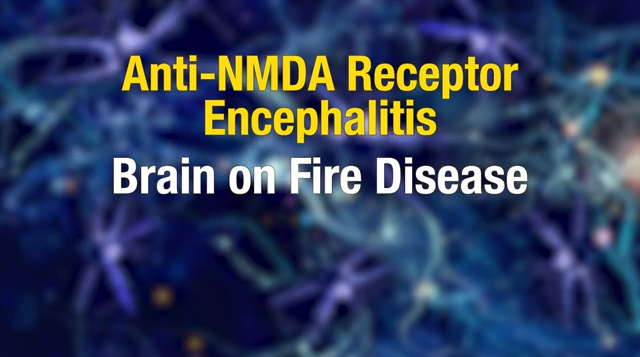SALT LAKE CITY, Utah. (Ivanhoe Newswire) – Imagine being totally fine one day, then the next, you’re having hallucinations, seizures, memory loss, and even trouble talking. It’s called brain on fire disease. Here’s the journey of one young woman who experienced this rare and mysterious illness.
Hunting, mountain biking, horseback riding — you name it, Katie Millar would do it, until she couldn’t.
“I just didn’t feel like myself, like normal,” she says.
“Katie said, ‘Mom, I feel like my brain snapped’,” her mom Colleen fearfully remembers.
Local doctors admitted Katie into a psychiatric ward, but what was happening to her wasn’t mental, it was physical.
Autoimmune neurologist at the University of Utah, Stacey Clardy, MD, PhD, explains, “What happens is you’re perfectly normal one day, and suddenly overnight, this person can become paranoid, can start having visual hallucinations, auditory hallucinations.”
Anti-NMDA receptor encephalitis – also known as brain on fire disease – is misdiagnosed as a psychiatric disorder in up to 40 percent of patients.
“So, for many of the females, especially after puberty, they can develop what’s called an ovarian dermoid cyst or an ovarian teratoma,” Dr. Clardy adds.
These cysts often have hair and teeth in them. The immune system sees it as foreign and attacks it, but there is a component of tissue that actually is brain tissue.
Within four days, Katie was catatonic and needed a ventilator to breathe. There is no single approved treatment. That’s why a five-year, nationwide clinical trial is testing whether a drug called Inebilizumab will stop the assault on the brain.
Katie had her cyst removed, but she can’t remember three months of her life. And now, and with various medications, Katie is on her way to recovery.
Up to 50 percent of patients can suffer long-term consequences, especially cognitive and mood symptoms. Recovery is also often slow — over months to years — and patients require prolonged hospital stays. The extinguished trial is enrolling at 26 sites all across the United States, and in Barcelona and the Netherlands. If you think you may have heard of this disease, it may be because the book “Brain on Fire” was written by journalist Susanna Cahalan who had NMDA receptor encephalitis. It was made into a movie in 2016.
Contributors to this news report include: Marsha Lewis, Producer; Roque Correa, Videographer & Editor.
To receive a free weekly e-mail on medical breakthroughs from Ivanhoe, sign up at: http://www.ivanhoe.com/ftk
Source:
https://www.ncbi.nlm.nih.gov/books/NBK551672
MEDICAL BREAKTHROUGHS
RESEARCH SUMMARY
TOPIC: BRAIN ON FIRE: SURVIVING A RARE AND MYSTERIOUS DISEASE
REPORT: MB #5213
BACKGROUND: Brain on fire disease, also known as anti-NMDA receptor encephalitis, is a rare neurological disorder that can cause inflammation in the brain. It occurs when the body’s immune system mistakenly attacks the NMDA receptors in the brain, which are responsible for regulating communication between nerve cells. Brain on fire disease is often misdiagnosed as other neurological disorders or psychiatric illnesses because its symptoms are similar to those of many other conditions. However, a blood or cerebrospinal fluid test can help diagnose the disease by detecting the presence of antibodies that attack the NMDA receptors in the brain. The disease is rare as it affects one in 1.5 million people a year.
(Sources: https://www.ncbi.nlm.nih.gov/pmc/articles/PMC3704309/
https://www.ncbi.nlm.nih.gov/books/NBK551672/)
DIAGNOSING: Brain on fire disease is often misdiagnosed as other neurological disorders or psychiatric illnesses because its symptoms are similar to those of many other conditions. However, a blood or cerebrospinal fluid test can help diagnose the disease by detecting the presence of antibodies that attack the NMDA receptors in the brain. Treatment for brain on fire disease usually involves a combination of immunosuppressive therapies and supportive care. This may include medications such as steroids, intravenous immunoglobulin, or plasmapheresis, which can help suppress the immune system and reduce inflammation in the brain.
NEW TECHNOLOGY: Inebilizumab is a monoclonal antibody that has been developed as a potential treatment for brain on fire disease. It works by targeting and inhibiting the B cells in the immune system, which are responsible for producing the antibodies that attack the NMDA receptors in the brain. The use of inebilizumab in the treatment of brain on fire disease represents a promising development in the field of neurological disorders. It has the potential to improve outcomes for patients who are not responding to other treatments and may also lead to fewer long-term neurological effects.
(Sources: https://www.neurologylive.com/view/state-care-autoimmune-encephalitis-extinguish-trial-inebilizumab
https://healthcare.utah.edu/publicaffairs/news/2022/03/brain-on-fire)
FOR MORE INFORMATION ON THIS REPORT, PLEASE CONTACT:
Kylene Metzger
If this story or any other Ivanhoe story has impacted your life or prompted you or someone you know to seek or change treatments, please let us know by contacting Marjorie Bekaert Thomas at mthomas@ivanhoe.com





